Related Research Articles
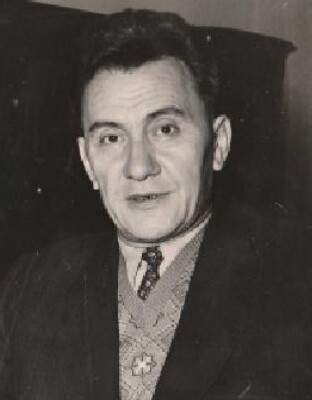
Dinmukhamed Akhmetuly "Dimash" Kunaev was a Kazakh Soviet communist politician who served as the First Secretary of the Communist Party of the Kazakh SSR.

The Nagorno-Karabakh conflict was an ethnic and territorial conflict between Armenia and Azerbaijan over the region of Nagorno-Karabakh, inhabited mostly by ethnic Armenians until 2023, and seven surrounding districts, inhabited mostly by Azerbaijanis until their expulsion during the 1990s. The Nagorno-Karabakh region was entirely claimed by and partially controlled by the breakaway Republic of Artsakh, but was recognized internationally as part of Azerbaijan. Azerbaijan gradually re-established control over Nagorno-Karabakh region and the seven surrounding districts.

The Police of the Republic of Armenia is the national police of Armenia.

On November 20, 1991, an Azerbaijani Mil Mi-8 military helicopter, carrying a peacekeeping mission team consisting of 13 Azerbaijani government officials, two Russian and one Kazakhstani Ministry of Internal Affairs officials, three Azerbaijani journalists and three helicopter crew was shot down amidst heavy fighting near the village of Berdashen, also known as Karakend, in Nagorno-Karabakh. All 22 people on board were killed in the crash. The incident is known in Azerbaijan as the ''Karakend tragedy''.
The Zheleznovodsk Communiqué, also known as the Zheleznovodsk Declaration or Zheleznovodsk Accords, is the joint peace communiqué mediated by Russian President, Boris Yeltsin and Kazakh President, Nursultan Nazarbayev in Zheleznovodsk, Russia on September 23, 1991, with an intention to end the three-year-long hostilities between Armenia and Azerbaijan over the Nagorno-Karabakh region, still an autonomous oblast of the Azerbaijan SSR. Although consensus was reached, the treaty was never ratified.

Khalaf Aly oghlu Khalafov is an Azerbaijani diplomat who is serving as Deputy Minister of Foreign Affairs of the Republic of Azerbaijan, Special representative of the President of the Republic of Azerbaijan for border and Caspian Sea issues.
Mass deportation of Azerbaijanis from Armenia took place several times throughout the 20th century, and sometimes some of them have been described by some authors as acts of forced resettlement and ethnic cleansing.
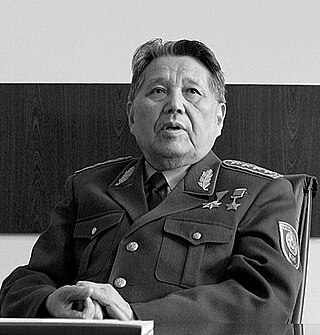
Sagadat Kozhakhmetovich Nurmagambetov was a Soviet and Kazakh general who served as Chairman of Kazakhstan's State Defense Committee in 1991-1992 and Kazakhstan's first Minister of Defense following the dissolution of the Soviet Union in 1991, holding the office of Defense Minister from May 1992 to November 1995. He was an adviser to Nursultan Nazarbayev in 1995-1996.

Sergey Alexandrovich Tereshchenko was a Kazakh politician. He served as the Prime Minister of Kazakhstan from 1991 to 1994 and later as the acting chairman of Otan from 1999 to 2002.

Zakir Asger oghlu Hasanov is an Azerbaijani politician and colonel general who has been the Minister of Defence of Azerbaijan since 2013.
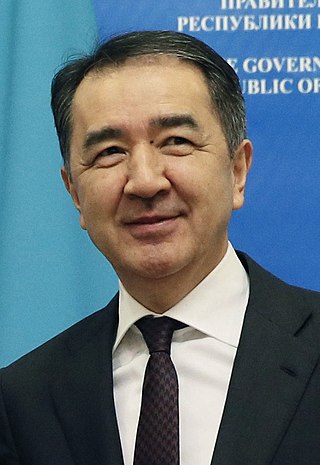
Bakhytzhan Abdiruly Sagintayev is a Kazakh politician who was a Prime Minister of Kazakhstan, from 9 September 2016 until his resignation on 21 February 2019. He served as the Äkim of Almaty from 28 June 2019 until he was replaced by Erbolat Dosaev on 31 January 2022 following the 2022 Kazakh unrest which greatly affected the city.

The Ministry of Internal Affairs of the Republic of Kazakhstan is the Kazakh government ministry which oversees the police and the National Guard of Kazakhstan. The Ministry is headed by the Minister of Internal Affairs of the Republic of Kazakhstan, appointed by the decree of the President of Kazakhstan. The Minister of Internal Affairs has 5 deputies, including the First Deputy Minister.
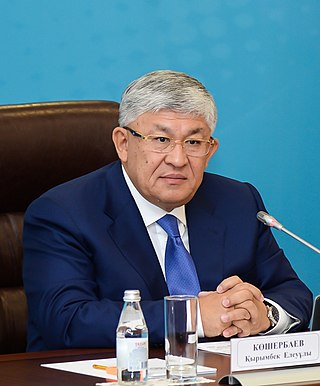
Krymbek Eleuuly Kusherbayev is a Kazakh politician who's serving as the State Secretary of Kazakhstan since 2019. Prior to that, Kusherbayev served as the head of the Presidential Administration, akim of Kyzylorda Region from 2013 to 2019, First Deputy Prime Minister of Kazakhstan from 2012 to 2013, akim of Mangystau Region from 2006 to 2011, Ambassador of Kazakhstan to Russia, Finland and Armenia from 2003 to 2006, akim of West Kazakhstan Region from 2000 to 2003, and the Minister of Education and Science from 1997 to 2000.
The 2016 Protests against land reforms in Kazakhstan were a massive, unauthorized protests that were held in Kazakhstan against the new amendments to the Land Code, which began on 24 April 2016 in the city of Atyrau. Three days later, the rallies were held in the cities of Aktobe and Semey. During the first three rallies, the authorities did not try to harshly suppress the protests, but tried to calm the protesters and offer other forms of dialogue. Only on May 21, the authorities thoroughly prepared to suppress any protests in all administrative centers of the republic. This was the first mass unrest in Kazakhstan since the Zhanaozen massacre in 2011.

The Second Nagorno-Karabakh War was an armed conflict in 2020 that took place in the disputed region of Nagorno-Karabakh and the surrounding occupied territories. It was a major escalation of an unresolved conflict over the region, involving Azerbaijan, Armenia and the self-declared Armenian breakaway state of Artsakh. The war lasted for 44 days and resulted in Azerbaijani victory, with the defeat igniting anti-government protests in Armenia. Post-war skirmishes continued in the region, including substantial clashes in 2022.
The Gugark pogrom was a pogrom directed against the Azerbaijani minority of the Gugark District in the Armenian SSR, then part of the Soviet Union.

The 2020 Dungan–Kazakh ethnic clashes or Korday conflict was an ethnic conflict between ethnic Kazakhs and ethnic Dungans in the village of Masanchi within the Korday District of Kazakhstan. As a result of the conflict, 11 people died, 185 were injured and 47 persons were arrested. It provoked damages costing around KZ₸1.7 billion and the displacement of around 20,000 people to neighboring Kyrgyzstan.
The ethnic conflicts in Kazakhstan refer to a series of insurgencies in Kazakhstan that date back to when the country was part of the Soviet Union, then known as the Kazakh Soviet Socialist Republic. These conflicts have largely been ethnic-based, although in recent years they have decreased in numbers. Some of these conflicts have called for the independence, or the increased autonomy of the group in the country.
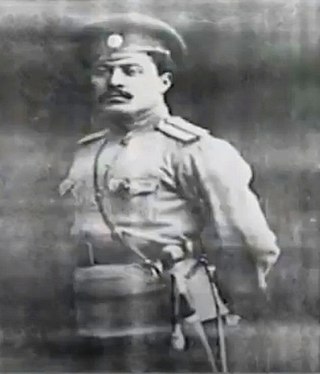
Tarlan Abdullah oglu Aliyarbayov, also known as Tarlan bey Abdullah bey oglu Aliyarbeyov, nicknamed the Tarlan of Shamakhi, was a Soviet military officer who served as a major general in the Red Army, a military educator and a politician of Azerbaijani origin. He previously served in the Imperial Russian and Azerbaijani armies, and served in World War I, for which he was awarded the Order of Saint Stanislaus and the Order of Saint Anna, as well as the Russian Civil War and the Armenian–Azerbaijani War. Aliyarbayov was one of three Azerbaijanis who fought in both World Wars and the Russian Civil War; the others were Ali-Agha Shikhlinski and Samad bey Mehmandarov.

The 2022 Kazakh unrest, also known as January Events, Bloody January, or the January Tragedy, was a series of mass protests and civil unrest that began in Kazakhstan on 2 January 2022 after a sudden sharp increase in liquefied petroleum gas prices following the lifting of a government-enforced price cap on 1 January. The protests began peacefully in the oil-producing city of Zhanaozen and quickly spread to other cities in the country, especially the nation's largest city, Almaty, which saw its demonstrations turn into violent riots, fueled by rising dissatisfaction with the government and widespread poverty. During the week-long violent unrest and crackdowns, 227 people were killed and over 9,900 were arrested, according to Kazakh officials.
References
- ↑ Sabri-Tabrizi. / Edited by Anoushiravan Ehteshami. — University of Exeter Press[en], UK, 1994. — P. 150. — ISBN 0859894304., G. Reza (1994). Azerbaijan and Armenian Conflict and Coexistence (англ.) // From the Gulf to Central Asia: Players in the New Great Game. Lecture Notes in Mathematics. Vol. 1358 (2nd expanded ed.). UK: University of Exeter Press. p. 150. doi:10.1007/b62130. ISBN 0859894304.
{{cite book}}:|last=has generic name (help)CS1 maint: multiple names: authors list (link) CS1 maint: numeric names: authors list (link) - ↑ Даурен ЗАРКЫМХАНОВ - Хранитель частицы истории страны
- ↑ РОМАН Ъ-ГЛЕБОВ (25 November 1991). "В Азербайджане сбит вертолет с VIP на борту". Kommersant. Archived from the original on 6 July 2013. Retrieved 22 April 2021.
- ↑ "Память погибших 25 лет назад в Нагорном Карабахе почтили в Алматы". mail.kz. 23 November 2016. Archived from the original on 22 April 2021. Retrieved 22 April 2021.
- ↑ "Сериков Сайлау Досумович". nkao.ru. Archived from the original on 22 April 2021. Retrieved 22 April 2021.